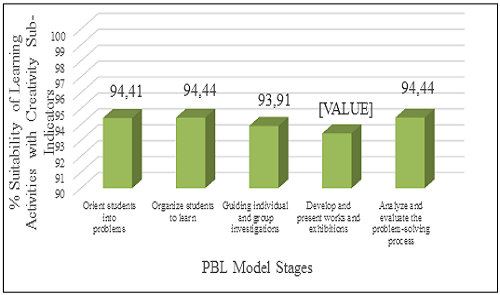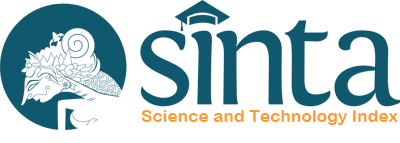
Feasibility Analysis of PBL Model to Build Student Creativity in Determining pH Route of Natural Indicator
Abstract
Keywords
Full Text:
PDFReferences
Agustin, N.H., Sarwanto., & Supriyanto, A. (2021). Problem Based Learning on Newton's Law: Can It Improve Student Creativity?. Jurnal Pendidikan Sains Indonesia, 9(4), 528-539.
Akaygun, S., & Aslan-Tutak, F. (2016). STEM Images Revealing STEM Conceptions of Pre-Service Chemistry and Mathematics Teachers. International Journal of Education in Mathematics, Science and Technology, 4(1), 56-71.
Alkhaf. (2020). Increasing Student Absorption in Natural Symptoms Materials through the Demonstration Method. Journal of Chemical Information and Modeling, 1(3), 1-13.
Demirhan, E., & Şahin, F. (2019). The Effects of Different Kinds of Hands-on Modeling Activities on the Academic Achievement, Problem-Solving Skills, and Scientific Creativity of Prospective Science Teachers. Research in Science Education, 1-19.
Florida, R., Mellander, C., & King, K. (2015). The Global Creativity Index 2015. Martin Prosperity Institute, 53–57.
Hmelo-Silver, C.E. (2004). Problem-Based Learning: What and How Do Students Learn?. Educational Psychology Review 16, 235–266.
Kanematsu, H., & Barry, D. M. (2016). STEM and Creativity. STEM and ICT Education in Intelligent Environments, 15-23. Cham:Springer.
KEMENDIKBUD RI. (2013). Permendikbud Nomor 81 A 2013. Implementasi Kurikulum Kurikulum, 1, 1–97.
Kenedi. (2017). Pengembangan Kreativitas Siswa dalam Proses Pembelajaran di Kelas II SMP Nergeri 3 Rokan IV Koto. Jurnal Ilmu Pendidikan Sosial, Sains, Dan Humaniora, 3(2), 329–348.
Lubis, F. A. (2018). Upaya Meningkatkan Kreativitas Siswa Melalui Model Project Based Learning. PeTeKa, 1(3), 192-201.
McVicker, C. J. (2007). Comic Strips as a Text Structure for Learning to Read. The Reading Teacher, 61(1), 85–88.
Newton, D. P., & Newton, L. D. (2009). Some student teachers’ conceptions of creativity in school science. Research in Science and Technological Education, 27(1), 45–60.
NGSS Lead States. (2013). Next Generation Science Standards: For States, by States (Appendix F – Science and Engineering Practices). Achieve, Inc. on Behalf of the Twenty-Six States and Partners That Collaborated on the NGSS, November, 1–103.
Pang, W. (2015). Promoting Creativity in The Cassroom: A Generative View. Psychology of Aesthetics Creativity and The Arts, 9(2), 122-127.
Plomp, T., & Nieveen, N. (2007). An Introduction to Educational Design Research. Netherlands institute for curriculum development.
Riduwan. (2015). Dasar-dasar Statistika. Bandung: Alfabeta.
Sawyer, R. K. (2012). Explaining creativity: The science of human innovation (2nd ed.). Oxford University Press.
Semmler, L., & Pietzner, V. (2018). Views of German chemistry teachers on creativity in chemistry classes and in general. Chemistry Education Research and Practice, 19(3), 711–731.
Shanahan, M.-C., & Nieswandt, M. (2009). Creative activities and their influence on identification in science: Three case studies. Journal of Elementary Science Education, 21(3), 63–79.
Silva, A. B. D., Santos, G. T. D., & Bispo, A. C. K. A. (2017). The Comics as Teaching Strategy in Learning of Students in An Undergraduate Management Program. Mackenzie Management Review), 18(1), 40-65.
Sugiyanto, F.N., Masykuri, M., & Muzzazinah. (2018). Analysis of Senior High School Students’ Creative Thinking Skills Profile in Klaten Regency. Journal of Physics: Conf. Series 1006, 1-6.
Tan, O. S. (2009). Problem-Based Learning and Creativity. Singapore: Cengage Learning.
Wahyu, W., Suryatna, A., Amalia, G. (2019). The Implementation of SSCS (Search-Solve-Create-Share) Model with Worksheet to Build Students’ Creativity on Making Simple Water Purifier in Chemistry Classroom. Unnes Science Education Journal, 8(3), 362-368.
Wahyuni, Sri, et al. (2019). Physics learning devices based on guided inquiry with experiment to improve students’ creativity. Journal of Physics: Conference Series, 1233(1), 012034.
Yusuf, I., Asrifan, A. 2020. Peningkatan Aktivitas Kolaborasi Pembelajaran Fisika Melalui Pendekatan Stem Dengan Purwarupa Pada Siswa Kelas XI IPA SMAN 5 Yogyakarta. Uniqbu Journal of Exact Sciences (UJES), 1(3), 32-48.
DOI: http://dx.doi.org/10.31258/jes.6.4.p.590-602
Refbacks
- There are currently no refbacks.
Copyright (c) 2022 Nafisah -

This work is licensed under a Creative Commons Attribution 4.0 International License.
Publisher: FKIP Universitas Riau












